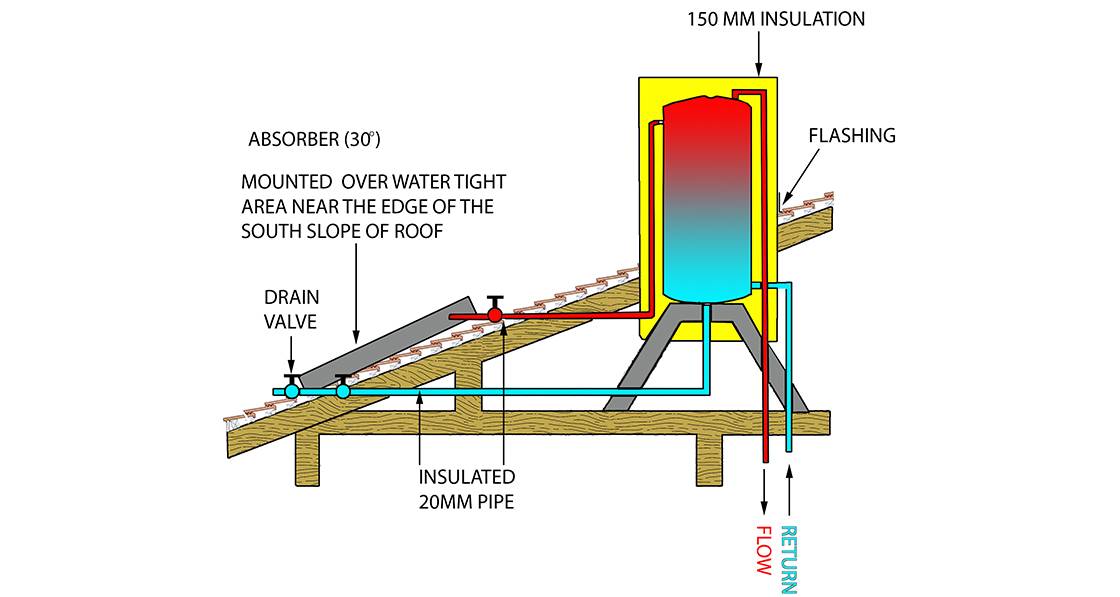
- Blogs
- Posted
Marc O'Riain: The golden age of solar water heating
Renewable energy technologies are often regarded as new and innovative, but in some instances their roots predate the oil age and go back to the start of the industrial revolution. Dr Marc Ó’Riain finds important insights in past failures of early solar thermal systems.
This article was originally published in issue 30 of Passive House Plus magazine. Want immediate access to all back issues and exclusive extra content? Click here to subscribe for as little as €10, or click here to receive the next issue free of charge
We often consider renewable energy technologies to be recent developments, perhaps as old as the first oil crisis in ’73-’74. It might come as very surprising that solar water heating technology was developed as early as 1760 and in widespread usage in California & Florida by 1900, prior to the widespread roll out of electrification.
In 1760, Horace de Saussure developed a solar heater with a rectangular pine insulated glass topped box, capable of heating air to 109C. The clear glass allowed a certain amount of solar radiation to be transmitted through the glass. The solar radiation was then absorbed by materials in the box construction and this ‘heat’ was slowly exchanged with the internal air increasing the overall temperature (Islam et al 2013).
In 1891, Clarence Kemp released the first ‘Climax’ solar water heater in Baltimore. He placed several water-filled iron elliptical tubes inside the box in series with cold water entering one side and warm water exiting from the other end. Multiple tubes avoided warm and cold-water being in close proximity, thus avoiding adverse heat exchanges. Although the collector heated water to 38.8C the weakness of the design was in its poor resistance to winter frosts and heat loss at night. A third of all homes in Pasadena and California had ‘Climax’ solar water heating by 1897 (Chiaro 2007).
William Bailey improved on the Climax with his ‘day and night’ collector in 1909. By separating the collector from the storage unit, and insulating the storage tank people could have hot water in the morning (see figure above).
The black painted collector had narrower water-filled pipes which were more efficient at absorbing solar energy aided by a thermosyphon system which required the storage tank to be mounted above the collector, with hot water rising to enter the top of the tank (Butti & Perlin, 1979). By 1920, Bailey had sold over 4,000 ‘day and night’ units and boom years for solar water heating followed in the 1930s.
After WW2 domestic usage of washing machines was on the increase and thereby the demand for domestic hot water.
Electrical boosters were fitted to new and existing installations. From 1938, the unit price of electricity started to fall steadily from 8c/kWh down to 2.5c/kWh by 1973. The cost of electrical water heaters continued to fall in comparison to the cost of solar installations. As such the dominant builder-developers adopted the cheaper electrical water heaters. Consumer confidence in solar water heating was damaged by leaking tanks, which, due to a corrosive reaction between the copper tubing and the steel tank, over-�flowed causing secondary damage to ceilings, furniture and flooring. Owners were faced with the choice of replacing a solar tank or moving to a cheaper electrical or gas hot water heating (Scott 1976).
As time moved on, solar water heater installations continued to rise in cost as the cost of electricity continued to fall. Even though solar hot water would still have resulted in long term cost savings, the duration of a mortgage, where families were trading up, would result in the savings being passed onto the following owner. The result would be a collapse of con�fidence and economics for a previously dominant renewable technology in southern latitudes.
This historical precedent provides an interesting parallel for contemporary policy makers. High capital cost low energy conservation strategies like heat pumps, external insulation, heat recovery ventilation systems and triple glazing may still represent a significant barrier to traditional homeowners, who may not recoup the value within their ownership, despite the existence of 30% government grants for some low energy strategies. Market acceptance of NZEB retrofit today may require the government to implement more targeted policies. Perhaps, there is a need to set a ten-year timeline for the phasing out of all oil and gas fired heating systems. We need to tell the consumer market that non-renewable home heating will increase by 10% per annum for the next ten years. We may need to increase the grant structures to 50% for all the aforementioned energy conservation strategies and we definitely need a 0% top up mortgage via the European Investment Bank if we are to see a significant increase in NZEB retrofit market penetration in the immediate future.




